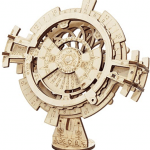Mechanical clock making is not just a craft; it’s a gateway to the past, a touch of engineering, and a potential goldmine for enthusiasts and entrepreneurs alike. If you’re looking to dive into a hobby that’s both intellectually stimulating and potentially profitable, mechanical clock making kits are your ticket to the show.
First, a quick history lesson.
The Rich History of Mechanical Clocks
Mechanical clocks date back to the 14th century, originating in Europe. These devices were marvels of their time, showcasing the ingenuity of early engineers. The first mechanical clocks were large, weight-driven mechanisms often housed in bell towers. They were the central timekeeping devices for entire towns.
Fast forward to today, and the tradition continues in miniature. Mechanical clock making kits allow you to recreate these historical timepieces, right from the comfort of your home or workshop.
Why Mechanical Clock Making Kits Are More Than Just a Hobby
So what’s the big deal with clock kits? Here are main reasons this hobby is more than just passing time:
- Educational Value: When you’re putting together a clock from a kit, you’re not just following instructions; you’re getting a hands-on education in mechanics and history.
- The Cool Factor: Let’s face it, there’s something undeniably cool about crafting a working clock from scratch. It’s a conversation starter and a showpiece.
- Aesthetic Appeal: The end result is not just a functional timepiece, but a stunning display of old-world craftsmanship that adds a touch of elegance to any space.
- Market Potential: Custom clocks and restoration services are in demand. With the right marketing and a bit of SEO magic, your clock-making hobby could rank well in search engines and clock up sales.
- You get hands-on experience with clockwork mechanics. It’s part history lesson, part engineering workshop.
- The final products have an old-world, steampunk vibe that looks flat-out awesome in your home or office.
- You can sell custom clocks on Etsy or via your own ecommerce site. There’s definite business potential here!
What are mechanical clock making kits used for and why would you need one.
Mechanical clock kits are DIY wooden puzzles you can use to create some quite attractive artwork pieces for your home. These unique mechanical clocks would probably be complicating to assemble for some, but will surely help you improve your brain’s thinking capability and processing speed.
These kits may not turn you into a genius, though they may make you feel like one. Normally most models of these clock kits won’t really display the time like a real clock, though it can work for some time with the weight mechanism without using any batteries.
If you’re someone who enjoys spending their time figuring out the science and technology behind a device’s working mechanism, crafting a mechanical clock can be a really rewarding hobby for beginners, kids and adults alike.
We’ve researched and compared several models to sort out the best mechanical clock making kits you can buy to build your own mechanical clock.
ROKR 3D Wooden Mechanical Pendulum Clock Kit
This old-style pendulum clock kit by ROKR helps you create a vintage mechanical clock. It’s made of more than 165 high-quality pre-cut pieces of plywood, which require no glue and are easier to assemble. The clock kit includes an informative guide and required tools that help you put the pieces together without any hassle. The mechanism can work for some hours after you complete the clockwork. It has a 13.6 × 4.6 × 9.2 Inches dimension and can easily fit on smaller desks or cabinets.
Pros:
- A very intricate industrial design
- It includes assembly tools and instructions
- It uses high-quality wood
- Works for around 7 hours in a single stretch
Cons:
- A little complicated to assemble for kids
Wooden City 3D Clock Kit
Wooden City’s mechanical kit allows you to design a modern clock, and the elegant woodcarving enhances this art piece’s beauty. The laser-cut 149 pieces of birch plywood are eco-friendly and long-lasting. It comprises two clock faces along with a pendulum. Despite an intriguing design, the clock doesn’t work for more than a few minutes. It’s recommended to buy the kit for the sole purpose of enjoying the DIY process. It provides a great means to improve your processing capabilities and spend your spare time with loved ones.
Pros:
- Made of eco-friendly materials
- The wood is carved with attractive patterns
- It doesn’t require glue to assemble
- Modern design
Cons:
- Clockwork mechanism works for very little time
ROBOTIME 3D Wooden Mechanical Gear Clock Kit
Many mechanical clocks don’t show accurate time, but it’s not the same with this model. It is a real clock that uses an easy to replace AA battery to display the time. The exclusive owl design is pretty simple to assemble with 102 laser-cut 3D wood pieces. It prevents the use of glue or wax, keeping your work desk clean.
The company also offers useful assembling accessories in an organized bag. Some extra wood pieces are also included in case of accidental damages. Overall, it’s an impressive pick for users who need a highly precise clock.
Pros:
- It uses a replaceable AA battery
- Displays accurate time 5-grade transmission
- Durable laser cut wood pieces
- Additional pieces provided for extra convenience
- Unique owl design
Cons:
- The alarm timer is not reliable
Abong David Mechanical Clock Making Kit
Abong David’s kit is one of the most expensive clock-making kits you’ll find in the market. It’s a premium mechanical clock that can work more than one and a half-day in a single stretch without utilizing any battery. It consists of around 100 puzzle pieces made of poplar hardwood and plywood.
Assembling tools like bearings and carbon axles are also provided in the kit. It’s a little tricky to assemble the clock, but clear instructions are provided in the manual. You’ll also require sandpaper and glue to complete this mechanical clock.
Pros:
- Works 36 hours without a battery
- Long-lasting birch plywood and hardwood material
- Effective assembling tools
Cons:
- Expensive
- Hard to assemble
Tips For Building Your Own Mechanical Clock With A Kit
Clock-making is a hobby that requires no prior experience or professional skills. The basic understanding of a clock’s mechanics and parts are enough for you to design mechanical clocks. For those eager to embark on this journey, here are some tips to help you with your clock making:
- Start with beginner-friendly kits to grasp the fundamentals before progressing to more complex designs.
- Engage with communities such as the National Association of Watch and Clock Collectors (NAWCC) to gain insights and connect with fellow enthusiasts.
- Consider exploring unique styles and designs to carve out a niche in the market, catering to the growing demand for distinctive timepieces.
- Handle the clock pieces with utmost care. Some of the puzzle pieces are delicate and can break with minor accidents. It isn’t easy to find replacement pieces for these mechanical kits. However, some brands do offer additional pieces or deliver on buyer’s requests.
- Don’t rush the crafting process, and read the instructions carefully. Clock-making is a slow process, and it can be tiresome to start over again.
- Although, most kits provide you laser-cut pieces that don’t require any glue. Make sure to use proper equipment and gloves when working with super glue to stick the pieces together.
Now, for some fascinating historical clock facts:
-
- Oldest Known Mechanical Clock: The oldest known mechanical clock dates back to 1386. Located in the Salisbury Cathedral in England, this clock still functions and displays the time.
- Invention of the Pendulum Clock: Dutch scientist Christiaan Huygens is credited with inventing the pendulum clock in 1656. The introduction of the pendulum greatly improved the accuracy of timekeeping.
- World’s First Alarm Clock: The first alarm clock was created by the ancient Greek philosopher Plato. His alarm clock used water to sound an alarm at a predetermined time.
- Invention of the Quartz Crystal Clock: The invention of the quartz crystal clock in 1927 marked a significant advancement in timekeeping precision. Quartz clocks are widely used today for their accuracy.
- Atomic Clock Precision: Atomic clocks, which use the vibrations of atoms to measure time, are incredibly precise. They lose or gain only about one second every 15 billion years.
- The Swiss Watch Industry: Switzerland is renowned for its watchmaking expertise. The Swiss city of Geneva is often referred to as the “Capital of Time” due to its long history of watchmaking.
- The Harrison Chronometers: John Harrison, an 18th-century English clockmaker, developed marine chronometers that revolutionized navigation by providing accurate timekeeping at sea. This significantly improved maritime navigation.
- Daylight Saving Time Origin: Daylight Saving Time (DST) was first proposed by Benjamin Franklin in 1784. However, it was not widely adopted until the 20th century as a way to make better use of daylight during the longer days of summer.
- Cuckoo Clocks and Black Forest Tradition: Cuckoo clocks, famous for their distinctive sound and animated figurines, originated in Germany’s Black Forest region in the 18th century. The clockmakers in the Black Forest are known for their craftsmanship.
- Big Ben’s Quarter Bongs: Big Ben, the iconic clock tower in London, is renowned for its accurate timekeeping. Interestingly, the chimes heard on the quarter-hour are the same notes found in the opening bars of the song “All You Need Is Love” by The Beatles.
- World’s Largest Clock: The Abraj Al Bait Clock Tower in Mecca, Saudi Arabia, is home to the world’s largest clock face. The clock’s minute hand alone is over 65 feet long.
- Rolex and Mount Everest: Sir Edmund Hillary and Tenzing Norgay wore Rolex Oyster Perpetual watches when they became the first men to reach the summit of Mount Everest in 1953.
- The pendulum swing was a 17th century breakthrough that made clocks way more accurate.
- Many credit the first portable spring-driven clocks to 15th century Burgundy, though the inventor remains unknown.
These fascinating clock facts showcase the rich tapestry of innovation, precision, and cultural significance woven into the history of timekeeping. Each tick and tock tells a story of human ingenuity and our perpetual quest to measure and master time.
Finally, some tips if you’re ready to try your hand at clock building:
- Start with beginner-friendly kits before attempting complex designs. Master the fundamentals first.
- Join communities like the NAWCC to connect with fellow clockmakers for advice.
- Consider specializing in unique styles to stand out in this niche market. Steampunk designs are particularly on trend.
Most of these mechanical clock making kits have mainly wooded parts which gives them a classy vintage and natural look. Though, if you like working with wood, you can delve into the equally fun and satisfying hobby of building wooden ship models with kits. So make sure to check it out too.
Final Words
DIY clock-making is a fun and creative way to spend your free time, especially if you’re a clock lover. The hobby requires extreme concentration and patience to make artwork. Fortunately, clock kits provide you all the tools and instructions you need for the job.
In essence, mechanical clock making kits offer a blend of historical enrichment, creative expression, and potential business prospects, making them an appealing pursuit for anyone with a passion for craftsmanship and a penchant for the timeless art of timekeeping.
We’ve listed some of the top-rated clock-making kits that you can check out to design antique or modern clocks.
So, grab a kit and get gearing!
Let me know if you have any suggestions, tips or comments on how to build better mechanical clocks with these wonderful clock making kits.





